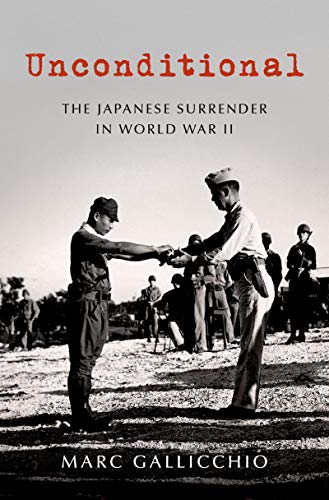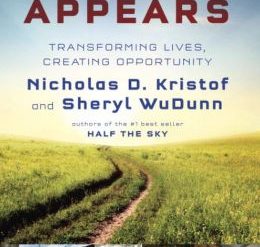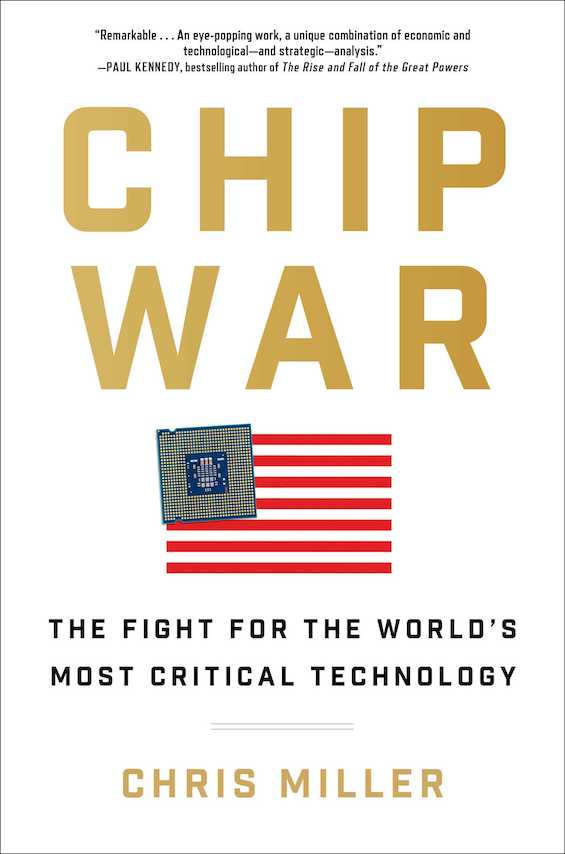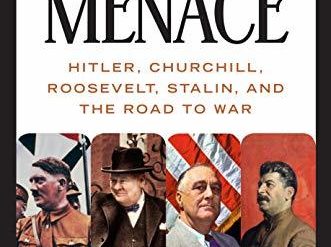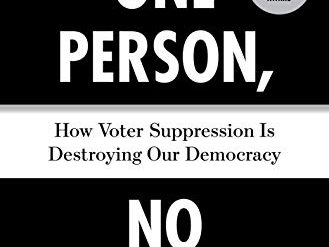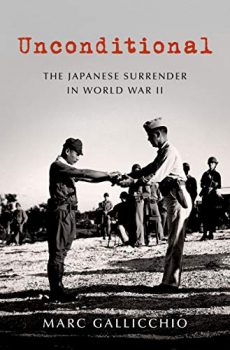
Three-quarters of a century after the end of World War II, FDR’s policy to demand unconditional surrender from Germany and Japan may seem simply logical. After all, in an era of total war, the only guarantee that either nation wouldn’t sufficiently recover to attack again was total Allied control over their system of government following the end of hostilities. That seemed assured in the case of Germany, which ended the war in rubble and ashes and divided between East and West. But unconditional surrender was a far more complex question with respect to Imperial Japan. For US President Harry Truman to pursue the policy to the end in 1945 involved a complex calculus weighing a host of mutually contradictory military, political, diplomatic, and economic factors. Villanova University historian Marc Gallicchio adroitly untangles them in Unconditional: The Japanese Surrender in World War II.
Unconditional: The Japanese Surrender in World War II by Marc Gallicchio (2020) 282 pages ★★★★☆

A new President assaulted on all sides with contradictory evidence
When FDR died on April 12, 1945, Harry Truman had served as Vice President for just 82 days. Much of what he learned in the months ahead was new to him, as Roosevelt had never taken him into his confidence. And the pressures he faced were monumental:
- Japanese diplomatic and military communications—which the Allies had secretly decoded—made it clear that Tokyo was determined to fight on, regardless of the cost and despite any offers the Allies might make.
- But peace feelers through neutral countries by influential Japanese businessmen encouraged some American officials to believe that a negotiated settlement was possible if only the Americans would allow Emperor Hirohito to remain on the throne. Conservatives seized on the opportunity to press the new President to drop the policy. However, it was clear to most observers that “the authority vested in the monarchy made it a bulwark against reform from below,” thus preventing the thoroughgoing political change needed to prevent a resurgence of imperial ambitions.
- Before mid-July, when Truman learned of Trinity, the successful atomic bomb test in New Mexico, American military commanders were divided about how to end the war with Japan. The internecine warfare between the US Army and Navy was growing more bitter by the day. Admiral Chester Nimitz was certain that a naval blockade would starve the Japanese and force them to accept unconditional surrender. General Douglas MacArthur was determined to invade and, to reduce the burden on the Army, insisted on the importance of drawing the USSR into the war in the Pacific.
- However, the invasion of the Japanese homeland planned for November appeared to be in question because sufficient shipping wasn’t available to move the three million GIs the Army demanded halfway around the world from Europe to the Pacific. One reason for the shortage was MacArthur’s refusal to part with the merchant shipping he controlled in southern waters.
- Military staff studies of the invasion plans suggested that the US might suffer half a million or more casualties. In fact, top-secret code intercepts made it clear that Tokyo was transferring a total of nearly 900,000 soldiers to the island of Kyushu, where the invasion was scheduled to begin. This was a buildup “that exceeded anything the Americans thought possible.” And the Japanese had identified the individual beaches where the troops were destined to land. Wholesale slaughter on Kyushu was a certainty.
- The American public was in a vindictive mood, demanding unconditional surrender of the Japanese and the prosecution of Japanese war criminals, starting with the Emperor.
- Meanwhile, “legislators, business leaders, organized labor, and public commentators all complained that the military, the Army in particular, was devouring the materials and manpower needed to begin the process of reconversion to a peacetime economy.” And Truman’s new Treasury Secretary, Fred Vinson, was “warning of impending economic disaster unless the administration took immediate steps to speed up reconversion.”
Despite these complexities and the mutually exclusive claims that presented themselves to him, President Truman remained resolute in insisting that the Japanese surrender unconditionally.
Wishful thinking hobbled both sides
In the final months of the war in the Pacific, key players on both the Japanese and American sides indulged in what can only be called wishful thinking.
- Emperor Hirohito and the militarists in power in Tokyo were convinced that the US would back down from demanding unconditional surrender and negotiate on terms favorable to Japan—if they could kill enough American soldiers and sailors. They believed the US public was weary of war and would find the mounting casualties unacceptable. While that might well have been the case had the war dragged on into 1946 (as US Army planners assumed would happen following an invasion), public opinion surveys suggested it was not true in the summer of 1945.
- In Washington, powerful figures in the White House, the War and Navy Departments, and the Congress were certain that “moderates” in the Japanese cabinet would seek—and, some thought, were seeking—to surrender, if only the US would permit them to keep the Emperor in place.
In fact, as Gallicchio makes clear, war weariness and a desire to restart the civilian US economy were pronounced in the spring and summer of 1945. But the American public was overwhelmingly in favor of unconditional surrender. In one major poll, fully one-third of respondents wanted Emperor Hirohito to be executed as a war criminal; others insisted he be put on trial for his crimes—which might lead to his execution.
Similarly, the American conservatives who insisted that high-level Japanese “moderates,” including the Emperor himself, were ready to surrender were simply wrong. Intercepted Japanese diplomatic and military communications made it clear that the Emperor was in full agreement with the hardline militarists dominating the cabinet. And the politicians identified by Truman’s critics as “moderate” continued to acquiesce to his wishes. As Gallicchio explains, the so-called moderates “were staunchly conservative, even reactionary, in domestic politics. Like the militarists, they also sought Japanese dominance of East Asia, although they [had] hoped it could be accomplished less violently and without antagonizing the United States.”
An illustrious cast of characters
Gallicchio devotes far more attention to the Americans who weighed in on the debates about unconditional surrender in the spring and summer of 1945 than he does to the key Japanese players. But the contours of the unfolding debate in both capitals are clear enough.
In Washington, most of the leading figures in the US government in the closing months of the Second World War became embroiled in the animated, and at times bitter, debate:
- President Harry Truman
- Secretary of War Henry Stimson
- US Army Chief of Staff George Marshall
- Secretary of the Navy James Forrestal
- Assistant Secretaries of State Dean Acheson and Archibald MacLeish
- Assistant Secretary of War John J. McCloy
- Acting Secretary of State Joseph Grew
- Secretary of State James Byrnes
General Douglas MacArthur and Admiral Chester Nimitz also figured prominently in the discussion. And the debate spilled over into the public domain as well, engaging former President Herbert Hoover, Time-Life publisher Henry Luce, New York Times military editor Hanson Baldwin, and radical journalist I. F. Stone, among many others.
The unconditional surrender controversy set the stage for the post-war political stand-off
Differences of opinion about the wisdom of demanding unconditional surrender of Japan hardened in the war’s final months. As the debate unfolded, the two sides solidified into conservative (hard-line anti-Communist) and liberal (pro-New Deal) factions. To view the matter more broadly, as Gallichio puts it, “the debate over the surrender of Japan signaled the end of coalition government in the United States.”
Conservatives criticized Harry Truman for passing up what they viewed as an opportunity to end the war without dropping the atomic bomb or allowing the Soviet Union to enter the conflict in the Pacific. Some even insisted that the New Dealers were pro-Communist and insisted on unconditional surrender in order to prolong the war so that the USSR would gain a chance to take part in dismembering Japan.
In fact, as Gallicchio notes, “Japan’s political class and Hirohito agreed to the restructuring of the monarchy only because the Americans were in control of Japan, a position they had obtained by compelling Japan’s unconditional surrender.” And the key to the emergence of democracy in post-war Japan was clearly relegating the Emperor to a symbol and stripping him of his political role.
The debate about Japan’s unconditional surrender colored political divisions after the war
“Unconditional surrender was destined to be controversial,” Galllicchio writes, “because it was Roosevelt’s policy. It incited the same ideological divisions as his domestic policies and extended those battles to the arenas of foreign policy and military strategy.”
And as the years rolled by, Herbert Hoover, Douglas MacArthur, and other harsh critics offered up increasingly fanciful arguments. A favorite of the hard-liners was that Hirohito had first sought peace in January 1945. Another was that the so-called moderates would have settled in July for any terms that might be called “unconditional surrender” if only Truman had agreed to allow the Emperor to remain on his throne. Both arguments were demonstrably false. But they helped fuel the fury in the anti-Communist wave that swept through Washington in the decade following the war.
Ironically, in the end, once the Japanese signed the documents specifying unconditional surrender, Truman did in fact allow Emperor Hirohito to remain on his throne. At the direction of the White House, MacArthur stripped him of his authority but enlisted him as a spokesman to persuade Japanese military commanders scattered all over South and Southeast Asia and the Pacific to lay down their arms.
For further reading
This book is one of the best Books about World War II in the Pacific.
Another excellent book that casts light on the same period is The Fall of Japan: The Final Weeks of World War II in the Pacific by William Craig (The ugly background to Japan’s unconditional surrender).
Of the scores of books about World War II that I’ve reviewed here, very few focus exclusively on the war in the Pacific. Those that do include:
- 1945 by Robert Conroy (What if Japan hadn’t surrendered?)
- The Emperor’s Codes: The Thrilling Story of the Allied Code Breakers Who Turned the Tide of World War II by Michael Smith (Did the British crack the World War II Japanese codes?)
- Rescue at Los Baños: The Most Daring Prison Camp Raid of World War II by Bruce Henderson (A true-life account of a spectacular WWII prison camp rescue)
- Forgotten Ally: China’s World War II, 1937-1945 by Rana Mitter (A gripping history of China in World War II)
You might also be interested in:
- 5 top nonfiction books about World War II (plus many runners-up)
- The 10 best novels about World War II (with 30+ runners-up)
- The 10 most consequential events of World War II
- Top 20 popular books for understanding American history
And you can always find my most popular reviews, and the most recent ones, plus a guide to this whole site, on the Home Page.

